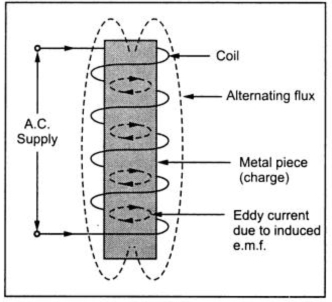 |
| Fig. 1 |
When alternating current flows in a conductor it produces
alternating flux. If any other conducting material is placed in this
magnetic flux which is alternating, the e.m.f. gets induced in the
conducting material. This induced e.m.f. drives eddy currents in that
piece. The power loss due to such eddy currents appears as heat. The
action of inducing e.m.f. in other material due to alternating flux
produced by a current carrying conductor is a transformer action.
Note : The only difference between transformer and induction
heating is in a transformer electrical energy available in secondary is
utilised outside secondary when in induction it is used to heat the
charge itself which acts as a short circuited secondary.
The heating effect due to such principle depends on following factors :
1. It is proportional to relative permeability. So heating produced in
magnetic material is more than non magnetic material. In addition to the
eddy currents, there is loss due to hysteresis in magnetic material
which contributes to generate more than heat. But hysteresis loss
becomes negligible at high fequencies.
2. For a given material and supply frequency, heating is proportional to
magnetomotive force (m.m.f.). The force can be varied either by
changing current or by varying number of turns of coil as m.m.f. is NI.
3. For a given material and magnetizing force, heating effect can be increased by employing high frequency supply.
The high power induction furnaces used to produce high quality
steel and other alloys based on principle of induction are often called
induction heating transformer.
1.1 Coreless Type Induction Heating Transformer
The Fig. 2 shows coreless type induction furnace using the transformer principle. |
| Fig. 2 coreless type induction heating transformer |
It consists of a crucible of cylindrical in shape with refractory
lining. Primary winding is wound around a crucible. The molten metal
acts as a short circuited secondary. The crucible can be infact of any
convenient shape. The furnace is generally operated at high frequency.
Due to this, skin effect exists which increase effective resistance of
primary winding. Due to this there are large copper losses and winding
gets heated. So primary winding is made hollow and water is circuited
inside for cooling purpose.
Operation
This furnace also operates on the principle of transformer. The
primary is connected to an alternating supply of frequency as high as
500 to 600 Hz. The magnetic flux produced by primary sets up eddy
current in the molten. This heat is used to melt the molten metal. The
l\electromagnetic forces produced does the stirring action. The
operating voltage is about 1000 to 2000 V for larger sizes and upto
10000 V for the smaller sizes.
Such induction heating furnaces have ratings varying from 15 KVA
to 40000 KVA. As power rating increases, the operating frequency
decreases. The power factor of such furnaces is very low (about 0.2) as
magnetising current required is large to drive the flux through molten
metal and air. To improve the power factor capacitor bank is required.
1.2 Channel Type Induction Heating Transformer
This type of induction heating furnace uses the core type
transformer. The iron core is linked to channel of molten iron as shown
in the Fig. 3.
 |
| Fig. 3 Channel type induction heating motor |
The ceramic pipe is used as a channel which is fitted to the
bottom of the crucible. A 50 Hz supply is used to excite the primary
winding. The induced current I2 flows through the channel and
the molten metal. The channel acts as single turn short circuited on
itself. The magnetising current is low as flux is required to be driven
through iron core having high permeability. The magnetic coupling
between primary and secondary is poor which results into large leakage
flux and hence leakage reactance. To keep its effect minimum, the normal
frequency supply is used. The power factor is higher than coreless type
(about 0.6 to 0.7). Thus smaller capacitor banks are required to
improve the power factor. Due to high temperatures the primary windings
are made hollow and water cooled.
1.3 Advantages of Induction Heating Transformer
The various advantages of induction heating transformer are,1. No danger of contamination of molten metal
2. The product composition can be accurately controlled.
3. The intermittent operation is possible.
4. No special starting procedure is necessary for such furnaces.
5. The method of heating is very clean.
6. The uniform heating of metal is possible.
1.4 Limitations of Induction Heating Transformer
The various limitations of induction heating transformer are,1. The power factor is low thus capacitor banks are required to improve the power factor.
2. Due to capacitor banks and need of high frequency supply, initial cost is high.
1.5 Applications
The induction heating furnaces are often used,1. To manufacturer high grade steel.
2. To melt the various alloys.
3. To melt the metals like aluminium, copper and iron.





Well written blog you shared. very informative.
ReplyDeleteSMPS Transformer Manufacturer in India | Toroidal Transformer in India